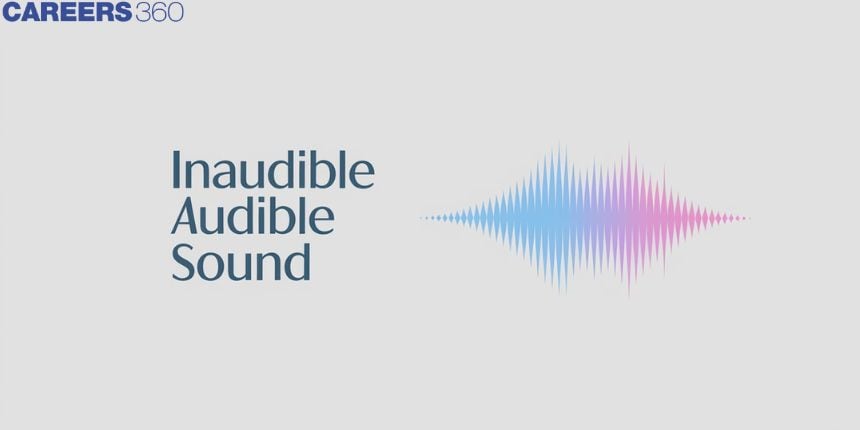Inaudible Audible Sound - Frequency Range and Vibration
A musical sound is pleasing to listen while noise is not. The meaning of audible is “Loud enough to be heard or able to be heard”. A sound is energy is vibrations made in the air, which are audible in living creatures. According to frequency, sound can be classified into audible or inaudible. In this article, we will discuss the concept of Audible and Inaudible sound, along with examples for better understanding.
This Story also Contains
- What is Audible Sound?
- What is Inaudible Sound?
- Difference between Audible Sound and Inaudible Sound
- Applications of Audible Sound
- Applications of Inaudible Sound

What is Audible Sound?
The sound waves ranging between 20Hz and 20 KHz are called Audible sound. SI unit of frequency is the hertz (Hz).
Frequency of Audible sound:
An audio frequency or audible frequency is a repeated vibration whose frequency is in the band audible to the common man, the human hearing range.
Low-frequency sounds (around 20 Hz ) are recognized as deep or bass sounds.
High-frequency sounds (close to $20,000 \mathrm{~Hz}$ ) are recognized as high-pitched sounds.
Human Hearing:
Hearing is determined by how the ear organ is formed, the ear canal, drum, and cochlea. According to the theories when sound waves get in touch with the eardrum, they make vibrations and these vibrations are converted into sound by the brain.
The 'normal' hearing frequency range of a fit young person is about 20 to 20,000Hz. However, a 'normal' audible range for noise or loudness is from 0 to 180dB, anything over 85dB is considered damaging, so we should try not to go there.
Also read -
- NCERT Solutions for All Subjects
- NCERT Notes For All Subjects
- NCERT Exemplar Solutions for All Subjects
Examples of Audible Sound:
Loud speech, songs, horns, and mechanical noises, squeaking or cracking noises, voices and shouts, music, birds singing, and a barking of a dog are all examples of sound that one can hear as an auditory sensation.
What is Inaudible Sound?
The sound that falls outside the range of human hearing is called an inaudible sound. The frequencies occupying below 20Hz and those occupying above 20 kHz cannot be recognized by the human ears. Therefore these frequencies are called audible sounds.
- Frequencies lower than 20Hz are referred to as Infrasonic Sound. These frequencies are felt as a vibration. Example- Earthquake, sounds produced by some animals like elephants or whales for long-distance communication.
- Frequencies higher than 20KHz are referred to as Ultrasonic Sound. Humans are unable to detect these sounds but they can be recognized using special equipment. Example- Sound waves used in Pest control, and medical ultrasound imaging.
Example of Inaudible Sound
The hearing range of animals like dogs can recognize the frequencies lying above 20 kHz. Therefore dogs are trained in police forces with the help of warble (Whistle) which serve as a source of frequencies greater than 20 kHz.
|
Related Topics |
Difference between Audible Sound and Inaudible Sound
Below table shows the key differences between Audible Sound and Inaudible Sound for easy understanding:
|
Audible Sounds
|
Inaudible sounds
|
| Audible sounds are sounds of frequency that are audible to the human ear | Inaudible sounds are sounds of frequency that are not audible to the human ear |
| The frequency of audible sound is usually 20 Hz -20 KHz. | The frequency of inaudible sound is usually less than 20 Hz and above than 20 KHz. |
| It can be heard by humans and animals | It can be heard by only some animal life like dolphin |
| Example: sounds with frequency from 20 Hz to 20, 000 Hz | Example: Sounds with frequency less than 20 Hz or more than 20,000 Hz |
Applications of Audible Sound
- Communication: Human speech and music are fundamental to communication.
- Entertainment: Music, movies, radio, and other items used sound within the audible frequency.
- Safety: Sounds like bells and horns call our attention to risks that are present like fire or thief.
Applications of Inaudible Sound
- Ultrasound: Applied in medicine for full-body scans without surgery, for instance, pregnancy scans.
- Infrasound: Used for purposes of identifying natural phenomena such as an earthquake or tsunami.
- Animal Communication: A lot of animals use low-frequency for communication to find their way like bats and dolphins.
Frequently Asked Questions (FAQs)
Most speech sounds vary from 30 to 70 decibels, the right human hearing frequency vary that describes mild-to-moderate hearing disorder.
Humans will hear about/the audible sound range for humans is/audible get human range of 20 Hz to 20kHz.
The intensity of sound at a point is the time rate of flow of sound energy passing normally through a unit area at the point. Its unit is the joule per sec. sq. m (J/s.m2) or watt per square metre (W/m2).
The frequency of sound determines its pitch. A high pitched or shrill sound is produced by a body vibrating with a high frequency and a low pitched or flat sound is produced by a body vibrating with a low frequency.
Frequency is a measurable quantity whereas pitch is not a measurable quantity.
The quality or timbre of the sound of a sitar is different from that of a guitar. The number of overtones or partials present and their relative intensities determine the quality or timbre of the sound of a musical instrument. Therefore, even if the pitch and the loudness are the same, the notes of a sitar and guitar sound different.
The frequency range is tested using frequency counter or spectrum analyzer.